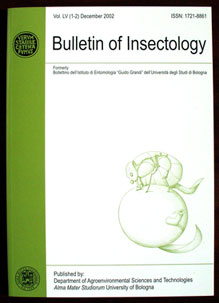Ver ítem
- xmlui.general.dspace_homeCentros e Institutos de InvestigaciónCICVyA. Centro de Investigación en Ciencias Veterinarias y AgronómicasInstituto de Microbiología y Zoología AgrícolaArtículos científicosxmlui.ArtifactBrowser.ItemViewer.trail
- Inicio
- Centros e Institutos de Investigación
- CICVyA. Centro de Investigación en Ciencias Veterinarias y Agronómicas
- Instituto de Microbiología y Zoología Agrícola
- Artículos científicos
- Ver ítem
First identification of bacterial endosymbionts in three South-American spittlebug pests: Notozulia entreriana, Deois mourei and Deois knoblauchii
Resumen
Spittlebugs cause major pasture damage in the Neotropics. As most xylem-feeders, they depend on microbial symbionts to supply essential amino acids to their diet. Here, the obligate nutritional endosymbiont ‘Candidatus Sulcia muelleri’ (Bacteroidetes) was detected in three main cercopid pests of South America: Notozulia entreriana (Berg), Deois (Deois) mourei Cavichioli et Sakakibara and Deois (Deois) knoblauchii (Berg) (Cercopidae Ishnorhininae). In all
[ver mas...]
Spittlebugs cause major pasture damage in the Neotropics. As most xylem-feeders, they depend on microbial symbionts to supply essential amino acids to their diet. Here, the obligate nutritional endosymbiont ‘Candidatus Sulcia muelleri’ (Bacteroidetes) was detected in three main cercopid pests of South America: Notozulia entreriana (Berg), Deois (Deois) mourei Cavichioli et Sakakibara and Deois (Deois) knoblauchii (Berg) (Cercopidae Ishnorhininae). In all insect species, bacteriomes were located laterally in the abdomen, and ultrathin sections of N. entreriana bacteriocytes showed typical sulcia-like bacteria. PCR and sequencing of a
914-bp fragment of the bacterial 16S rRNA gene revealed 100% nucleotide identity among sulcia strains obtained from the three host species. These sequences were also identical to those previously obtained from two other New World spittlebugs of the same subfamily, providing evidence for host/symbiont coevolution. Microscopic and molecular analyses suggested that N. entreriana
lacked additional symbionts (i. e. ‘Candidatus Zinderia insecticola’ or sodalis-like bacteria [Proteobacteria]) that often co-occur with sulcia within members of the superfamily Cercopoidea. Though amplicons were occasionally generated from D. (D.) mourei and D. (D.) knoblauchii with primers intended for zinderia, they failed to sequence. Further research is needed to elucidate the identity of bacteria other than sulcia in Deois spp.
[Cerrar]

Autor
Foieri, Alvaro;
Decker Franco, Cecilia;
Marino de Remes Lenicov, Ana María;
Arneodo Larochette, Joel Demian;
Fuente
Bulletin of Insectology 75 (1) : 15-20 (junio 2022)
Fecha
2022-06
Editorial
Alma Mater Studiorum, Università di Bologna
ISSN
2283-0332
1721-8861
1721-8861
Formato
pdf
Tipo de documento
artículo
Palabras Claves
Derechos de acceso
Abierto
 Excepto donde se diga explicitamente, este item se publica bajo la siguiente descripción: Creative Commons Attribution-NonCommercial-ShareAlike 2.5 Unported (CC BY-NC-SA 2.5)
Excepto donde se diga explicitamente, este item se publica bajo la siguiente descripción: Creative Commons Attribution-NonCommercial-ShareAlike 2.5 Unported (CC BY-NC-SA 2.5)


